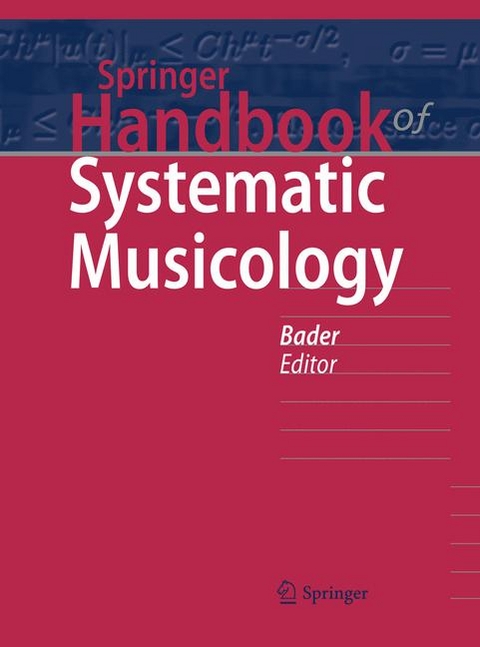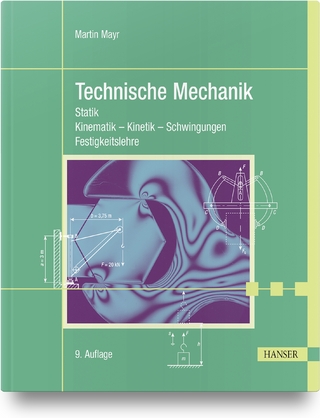
Springer Handbook of Systematic Musicology
Springer Berlin (Verlag)
978-3-662-58552-8 (ISBN)
- Titel ist leider vergriffen;
keine Neuauflage - Artikel merken
Rolf Bader is professor for Systematic Musicology at the Institute of Systematic Musicology at the University of Hamburg, Germany. He studied Systematic Musicology, Physics, Ethnology and Historic Musicology at the University of Hamburg. There he obtained his PhD and habilitation on topics of Musical Acoustics, Music Psychology and Musical Signal Processing. He was a visiting scholar at the Center for Computer Music and Research (CCRMA) at Stanford University in 2005/2006. His major fields of research are Musical Acoustics and Musical Signal Processing, Musical Hardware and Software Development, Music Psychology and Neurocognition, Music Ethnology and Philosophy of Music. He is co-editor of the Springer series Current Research in Systematic Musicology. He published several books as an author, such as Nonlinearities and Synchronization in Musical Acoustics and Music Psychology or Computational Mechanics of the Classical Guitar. Additionally he edited Sound - Perception - Performance and Concepts, Experiments, and Fieldwork: Studies in Systematic Musicology and many contributing book chapters or peer-reviewed papers. He conducted fieldwork as an ethnomusicologist in Bali, Nepal, Thailand, Cambodia, Myanmar, Sri Lanka, China and India since 1999. He was also working as a professional musician, composer and artist, running recording studios, working as a music journalist, leading exhibitions and running a cinema.
Systematic Musicology: a historical interdisciplinary perspective. - Part A: Musical Acoustics.- Vibrations and Waves. - Wave in 2D and 3D. - Construction of Wooden Musical Instruments. - Measurement Techniques. - Stringed Instruments. - Modeling of Wind Instruments. - Properties of the Sound of Flue Organ Pipes. - Percussion Musical Instruments. - Musical Instruments as Synchronized Systems. - Room Acoustics. - Part B: Signal Processing. - Music Studio Technology. - Delay-Lines and Digital Waveguides. - Convolution, Fourier Analysis, Cross-correlation and their interrelationship. - Adaptive Musical Control of Time-Frequency Representation. - Audio Source Separation in a Musical Context. - Finite-Difference Schemes in Musical Acoustics. - Wave Field Synthesis. - Optical Music Recognition. - Real-time Signal Processing Applications on Field Programmable Gate Arrays (FPGA). - Part C: Music Psychology and Physiology. - Auditory Time Perception. - Auditory Sensory Memory. - Long-term memory for music. - Auditory Working Memory. - Musical Syntax I: Theoretical Perspectives. - Musical Syntax II: Empirical Perspectives on Syntactic Processing. - Rhythm and Beat Perception. - Music and Action. - Music and Emotions. - Part D: Psychophysics and Psychoacoustics. - Fundamentals. - Pitch and Pitch Perception. - Perception of Timbre and Sound colour. - Sensation of sound intensity and perception of loudness. - Part E: Music Embodiment. - Embodied Music Cognition. - Sonic Object Cognition. - Embodied music cognition for health and well-being. - A conceptual framework for music-based interaction systems. - Methods for studying music-related body motion. - Part F: Music and Media. - Content-based methods for knowledge discorery in music. - Hearing Aids and Musicians. - Music Technology and Education. - Enabling Interactive and Interoperable Semantic Music Applications. - The relation between music technology and music industry. - Computational Ethnomusicology. - Automatic music composition and singing voice assessment. - Digital Sensing of Musical Instruments. - Part G: Music Ethnology. - Interaction between Systematic Musicology and Research on Traditional Music. - Analytical Ethnomusicology. - Musical Systems of Sub-Saharan Africa. - Music among ethnic minorities in Southeast Asia. - Music Archaeology. - The complex dynamics of improvisation. - Music of struggle and protest in the 20 th century.
Musical Acoustics.- Physics.- Introduction: Ancient Musical Instruments.- Organology.- Mathematical Foundation.- Stringed Instruments.- Reed Instruments.- Flue Instruments.- Percussion Instruments.- Physical Modelling.- Nonlinearities, Synchronization.- Room Acoustics.- Signal Processing.- Introduction: From Electro to Electronic.- Spectrum, Filter, Impulse Response.-Sound Synthesis Methods.- Amplification, Sound Systems.- Delay-Lines, Waveguides.- Sound-Source Separation.- Automatic Score Extraction.-Wavelets.- Autoregressive Spectrum, Linear Predictive Coding.- Wavefield Synthesis.- Music Psychology.- Physiology.- Introduction: The origin of music.- The inner and outer ear.- EEG, fMRI.- Auditory Pathway.- Auditory Cortex.- Audition and Movement.- Audition and Vision.- Rhythm and the Brain.- Emotion.- Binaural Hearing and Spaciousness.- Perception/Action/Motivation.- Introduction: Mind - Matter - Music.- Psychoacoustic Foundations.- Statistical Methods.- Timbre.- Loudness, Roughness, Sharpness.- Pitch.- Melody, Texture, Form.- Rhythm.- Memory.- Music Ethnology.- Traditional Music of the World.- Introduction: History of Comparative Musicology and Ethnomusicology.- Europe.- Africa.- Middle Asia.- Southeast Asia.- China.- North America.- Middle and South America.- The Pacific.- Popular Music.- Introduction: History of Popular Music Studies.- Jazz.- Rock'n Roll, Beat.- Folk.- Jazzrock, Fusion.- Classic Rock.- World Music.- Techno, Dance.- Hip-Hop.- Electro.- Music Theory.- Musical Texture.- Introduction: Philosophy and System.- Riemann: Funktionsharm
| Erscheinungsdatum | 11.08.2019 |
|---|---|
| Reihe/Serie | Springer Handbooks |
| Zusatzinfo | XXXIII, 1094 p. 952 illus., 90 illus. in color. |
| Verlagsort | Berlin |
| Sprache | englisch |
| Maße | 193 x 260 mm |
| Gewicht | 2834 g |
| Themenwelt | Kunst / Musik / Theater ► Musik |
| Naturwissenschaften ► Physik / Astronomie ► Mechanik | |
| Technik ► Maschinenbau | |
| Schlagworte | Musical Acoustics • Music and Media • Music Ethnology • musicology • music psychology • music theory • Systematic Musicology |
| ISBN-10 | 3-662-58552-9 / 3662585529 |
| ISBN-13 | 978-3-662-58552-8 / 9783662585528 |
| Zustand | Neuware |
| Haben Sie eine Frage zum Produkt? |
aus dem Bereich


